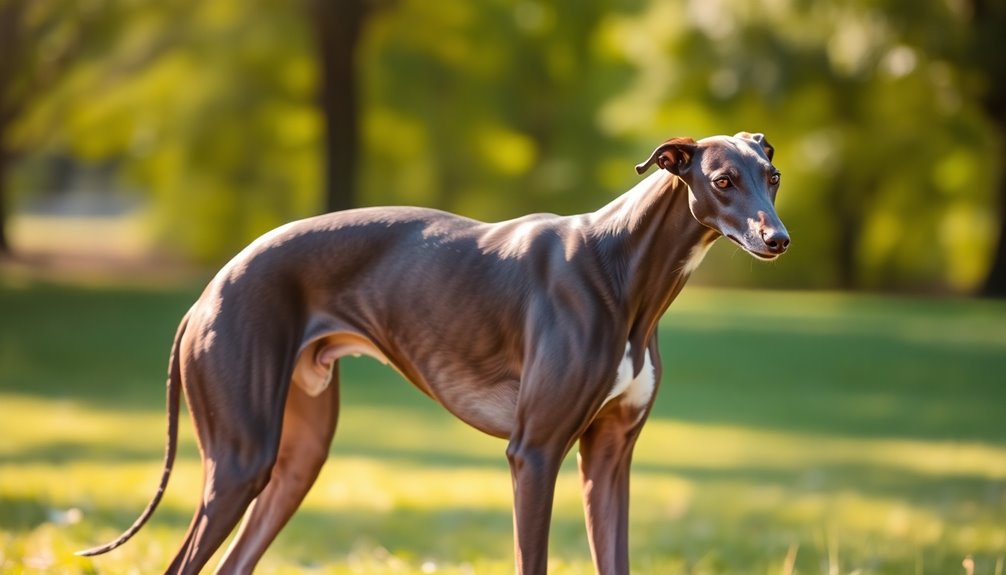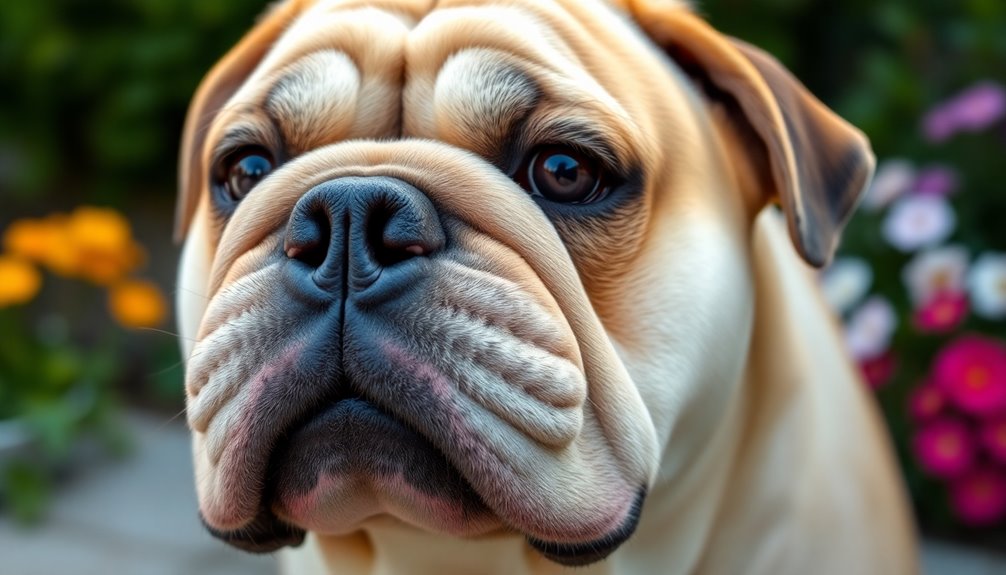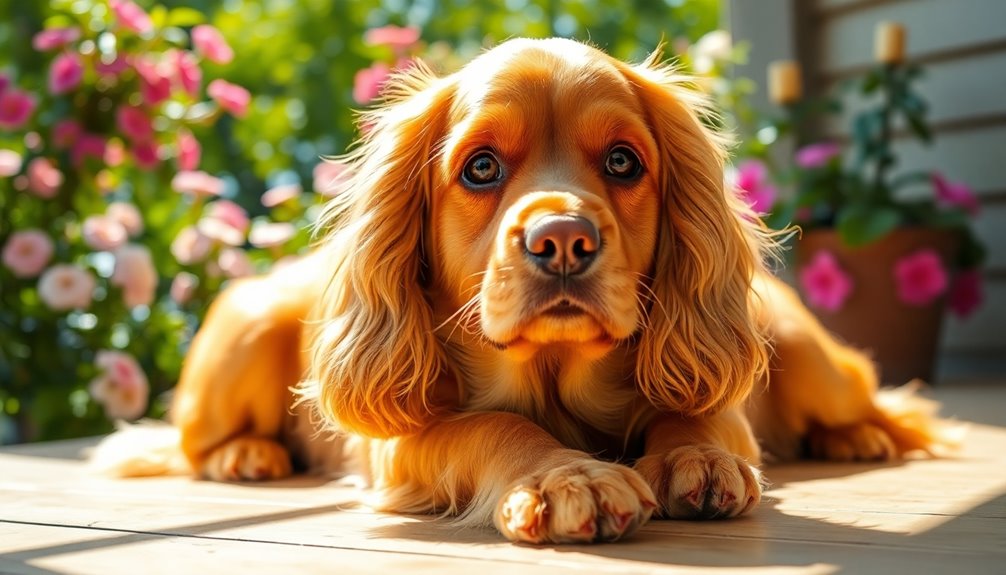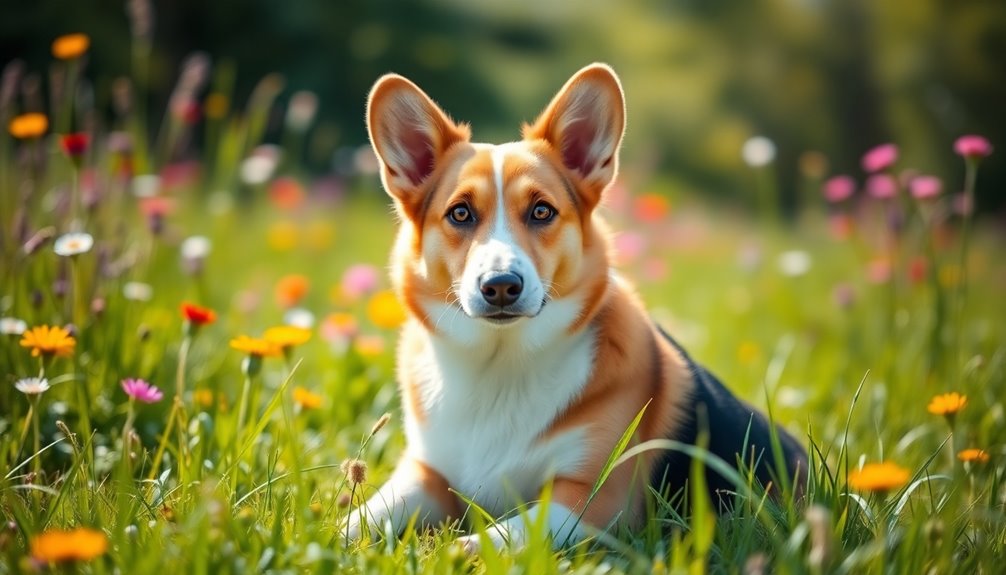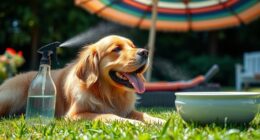The Miniature Pinscher, affectionately known as the "King of Toys," is a small but feisty companion that stands 10 to 12.5 inches tall and weighs only 8 to 10 pounds. With their vivacious personality, stunning coat, and sleek build, they're hard to resist. These curious pups need plenty of exercise—around 30 to 60 minutes daily—to stay happy and healthy. Their strong bond with owners makes them loving pets, but they thrive on early training and socialization. If you want to uncover more about their unique traits and care needs, you're in for an insightful journey.
Key Takeaways
- Miniature Pinschers are affectionate, loyal companions, making them ideal pets for families and individuals alike.
- Their energetic nature requires 30 to 60 minutes of exercise daily, keeping them active and engaged.
- Known for minimal grooming needs, they only require weekly brushing and occasional baths, making them low-maintenance.
- With a bold personality and high intelligence, they excel in training and socialization when approached positively.
- Originating as skilled vermin hunters, they possess a keen curiosity and agility, reinforcing their title as the "King of Toys."
Introduction
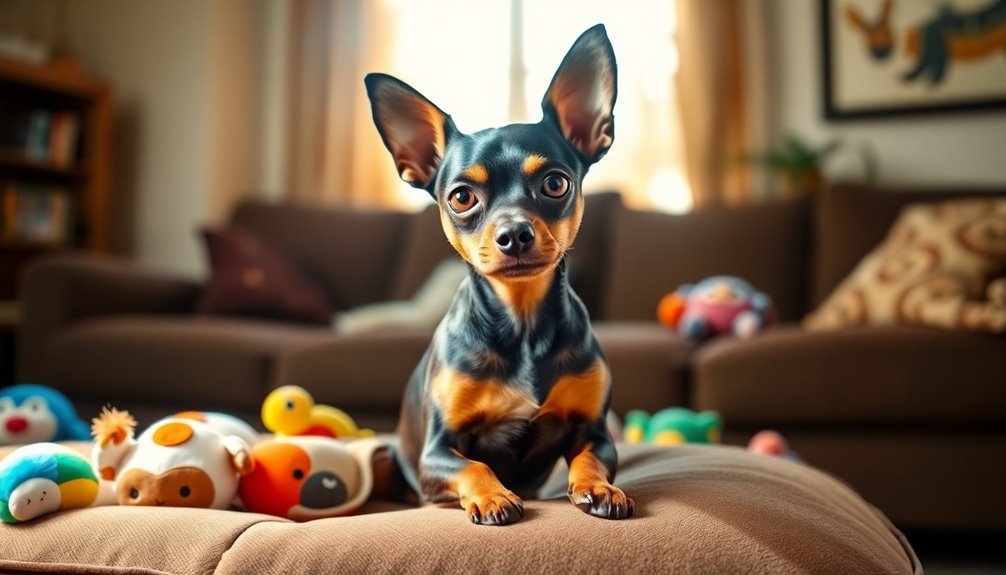
The Miniature Pinscher, often affectionately called the "Min Pin," is a spirited and compact breed that captures attention with its striking appearance and lively personality. Standing at just 10 to 12.5 inches tall and weighing between 8 to 10 pounds, this breed boasts a sturdy, wedge-shaped build and a smooth, shiny coat available in a variety of colors, including solid red and black with rust markings.
Min Pins are known for their high energy and playful nature, requiring about 40 minutes of exercise daily. They thrive on interactive play and can keep you entertained for hours. Additionally, their high-stepping hackney gait adds to their unique charm as they move.
Affectionate and loyal, they bond closely with their families, making them excellent companions, especially for those with children and cats. However, their vigilant nature means they can be suspicious of strangers, serving as effective watchdogs.
While intelligent and eager to learn, they can also be stubborn and mischievous, necessitating consistent training and supervision. Despite their low grooming needs, you'll want to keep an eye on them to prevent escapes or mischief.
History and Origin
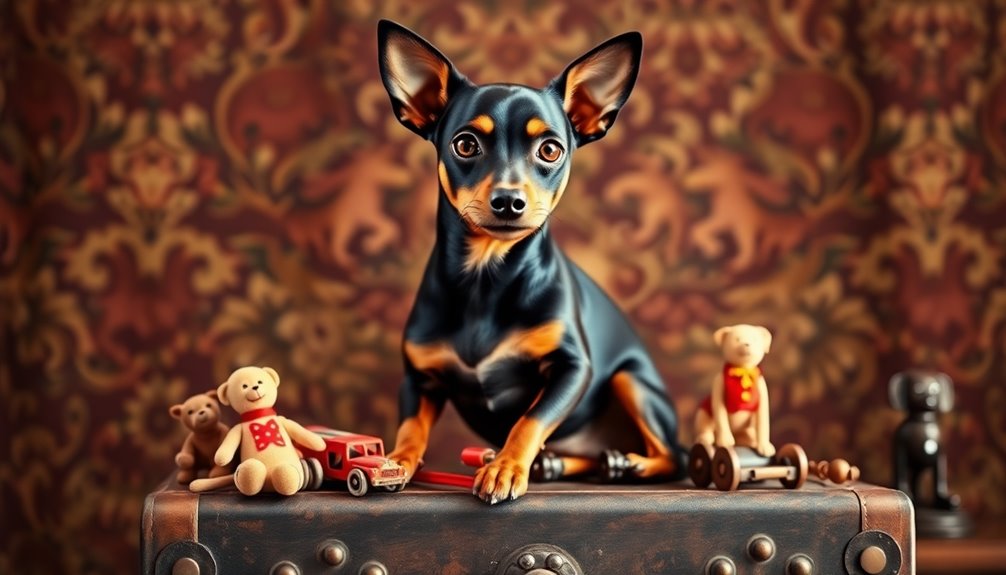
The Miniature Pinscher originated in Germany several centuries ago, where it was primarily bred for rat control and vermin hunting.
You'll find its ancestors include the German Pinscher, Dachshund, and Italian Greyhound, all contributing to its unique traits.
Understanding its history gives you insight into the breed's energetic and confident nature today. This breed is often referred to as Zwerg Pinschers in its native country, reflecting its historical purpose and stature.
Where and when the breed originated
Originating in Germany, the Miniature Pinscher has its roots deeply embedded in the European region, specifically traced back to the 1600s. Historically referred to as Zwerg Pinschers, or Dwarf Pinschers, this breed was developed through a mix of German Pinschers, Italian Greyhounds, and Dachshunds.
It's likely that the Black and Tan Terrier and the shorthaired German Pinscher also influenced the breed's formation. The first documentation of the Miniature Pinscher was dated in 1880, highlighting its established presence in the canine world.
Official documentation of the Miniature Pinscher began less than 200 years ago, with the first breed show occurring in Switzerland in 1882. By 1900, the first special show for Reh Pinschers took place in Stuttgart, Germany.
Following World War I, the breed regained popularity, particularly in 1926.
The German Kennel Club played a significant role in the breed's recognition, officially recognizing it in the late 1800s. However, it wasn't until 1972 that the name was officially changed to Miniature Pinscher in the U.S.
The breed has since spread to other countries, including Denmark, France, Belgium, Switzerland, and England, establishing itself as a beloved toy breed across Europe and beyond.
Rat Control and Vermin Hunting
As the Miniature Pinscher evolved, its primary purpose became clear: rat control and vermin hunting. Bred specifically to tackle pests like rats and mice, these little dogs excelled in homes and stables, protecting food supplies and reducing disease spread. Their small size and agility, combined with keen senses, made them expert hunters.
With a sleek, short coat that prevented rats from getting a grip, their pointed, erect ears sharpened their hearing, allowing them to detect even the faintest movements. Compact and muscular, Miniature Pinschers navigated tight spaces with ease, using their high energy and speed to chase down vermin swiftly. This breed's fearless and energetic nature allows them to tackle challenges that other dogs might shy away from.
Though their primary role has shifted, the Miniature Pinscher maintains a strong prey drive and hunting instinct. This fearless disposition enables them to confront pests despite their size, making them effective in eradicating vermin from homes.
While they now thrive as beloved companions, their historical role in vermin control continues to shape their behavior, requiring regular exercise and mental stimulation. Today, they're not just pets; they're spirited guardians with a rich heritage of hunting prowess.
Physical Characteristics
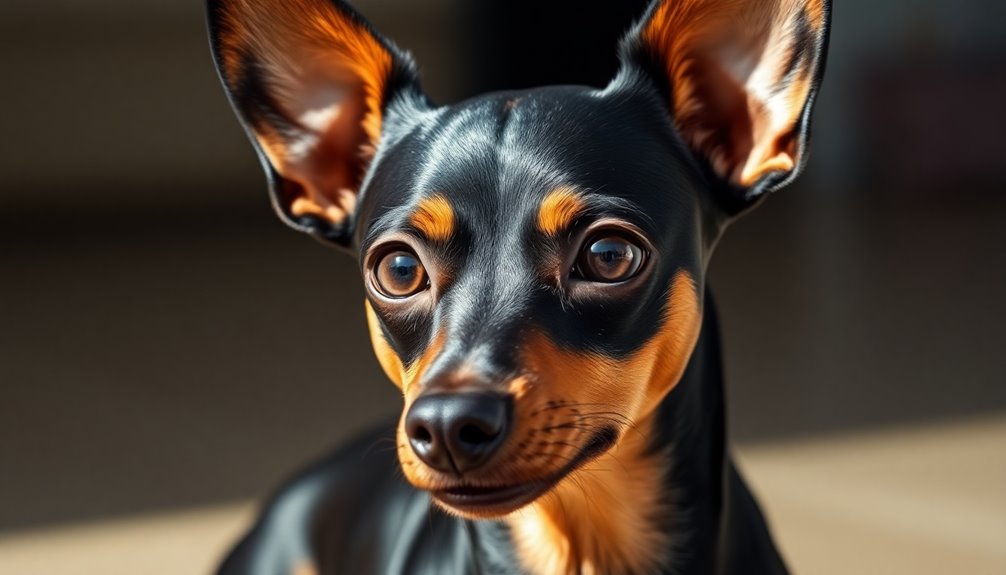
When you look at a Miniature Pinscher, you'll notice their compact size, averaging 10-12.5 inches tall and weighing between 8-10 pounds. Their smooth, shiny coat comes in various colors, adding to their distinctive appearance. With a sleek texture that requires minimal grooming, these dogs aren't only eye-catching but also practical for pet owners. Additionally, their life expectancy averages 10-14 years, making them a long-term companion for families.
Size, weight, and coat details
The Miniature Pinscher's compact size and striking coat make it a distinctive breed. Standing at a height of 10 to 12.5 inches at the shoulder, the ideal Miniature Pinscher measures between 11 and 11.5 inches. Generally, their length matches their height, though females might be slightly longer.
If you're considering a Teacup Miniature Pinscher, keep in mind they're about half the size of their standard counterparts.
When it comes to weight, these dogs typically range from 8 to 10 pounds, though some adults may weigh up to 12 pounds. Puppies start at just 0.2 to 0.3 pounds at birth, reaching 9 to 12 pounds by their first birthday. Their growth continues until around 18 months, influenced by genetics and overall care. The Miniature Pinscher is classified as a Toy breed, ensuring its small stature complements its lively personality.
The Miniature Pinscher's coat is often seen in solid red, stag red, black, or chocolate with rust markings, among other accepted colors. While slight variations exist, certain colors are disqualified in the show ring.
With their smooth, short coat and low grooming needs, caring for a Miniature Pinscher is straightforward, making them an appealing choice for many dog lovers.
Short, Sleek Coat Texture
Exhibiting a short and smooth coat, the Miniature Pinscher boasts a sleek appearance that enhances its overall charm. This breed has no undercoat, which means you won't see any extra fluff—just a beautifully polished finish.
The Miniature Pinscher is naturally well-groomed, requiring minimal grooming on your part. You'll only need to give its coat a brief brush with a soft-bristled brush once a week.
While shedding does occur, especially during shedding season, you can expect only tiny short hairs to land on your furniture and clothing. The coat comes in a variety of striking colors, including solid red, stag red, and the classic black and tan combination. Less common shades like chocolate with rust or fawn (Isabella) with tan add to their unique appeal.
Despite its sleekness, special care is needed. Make sure to keep your Miniature Pinscher warm in cold weather, as they don't tolerate extremes well. Additionally, their high energy level means they thrive best in active households that can provide sufficient exercise and mental stimulation.
Avoid leaving them outside for extended periods, and don't forget to protect them from the sun in warmer months. A little extra attention keeps your Miniature Pinscher's coat looking fabulous and its spirit high!
Temperament and Personality
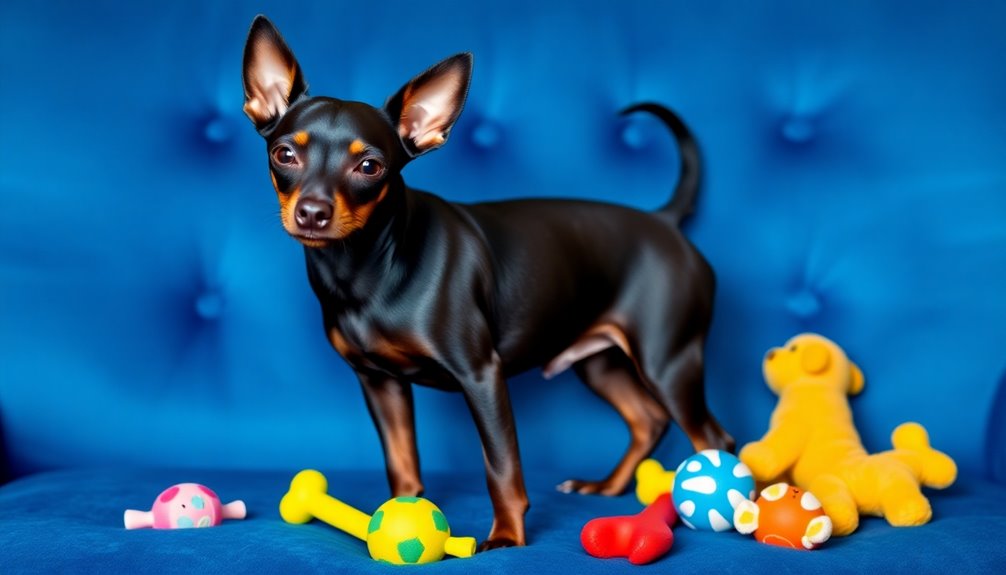
When you bring a Miniature Pinscher into your home, you'll quickly notice their playful and spirited demeanor. They're not just great companions for individuals; they can fit well into family settings and even get along with other pets when socialized correctly. Their bold personality adds an exciting dynamic to any household. Additionally, their fearless and clever nature makes them excellent watchdogs, ensuring your home is well protected. These dogs thrive on strong emotional bonds, which can lead to a deeper connection with their owners.
Playful and Spirited Demeanor
With a boundless energy that keeps them always on the move, Miniature Pinschers embody a playful and spirited demeanor that makes them an engaging companion.
These fearless little dogs thrive on activity, needing one to two hours of exercise each day. Their high-energy nature makes them excellent playmates for children, as they're always up for a game or an adventure.
However, if left alone for extended periods, they can become bored and develop separation anxiety. Their inquisitive nature keeps them constantly exploring, and they often find mischief if not adequately stimulated. Miniature Pinschers were originally bred as ratters, showcasing their instinctive hunting skills.
Miniature Pinschers are also known for their alertness, barking at visitors and unusual occurrences, making them natural watchdogs. They're suspicious of strangers but incredibly loyal and affectionate toward their families.
Training them can be a challenge due to their stubbornness and tendency to lose focus. Yet, with consistent training and positive reinforcement, they can learn a wide range of tasks.
You'll find that their cleverness shines through when they're engaged, making it essential to keep them busy both mentally and physically. Their spirited demeanor ensures that life with a Miniature Pinscher is anything but dull!
Suitability for families, individuals, or other pets
Miniature Pinschers bring their spirited energy not just to playtime but also to family dynamics, making them a lively addition to households.
They're affectionate toward people and children, though they can be a bit rough, so families with older kids are ideal. Early training and socialization are essential to ensure they behave well around children. Their protective nature also makes them excellent watchdogs. Miniature Pinschers have a historical role as farm rat catchers, showcasing their energetic and alert demeanor.
For active individuals, Miniature Pinschers are fantastic companions. They thrive on exercise and mental stimulation, so you'll need to keep them engaged.
While they can adapt to apartment living, regular activity is crucial to prevent boredom and misbehavior.
When it comes to other pets, compatibility varies. They can be aggressive with unfamiliar dogs, especially if not well-socialized, so pairing them with smaller breeds can work best.
If you have cats, proceed with caution; their moderate to high prey drive means they might chase. With slow introductions and positive reinforcement, they can coexist, but ongoing supervision is vital to ensure safe interactions.
With the right approach, your Miniature Pinscher can fit smoothly into your family or individual lifestyle.
Health and Lifespan
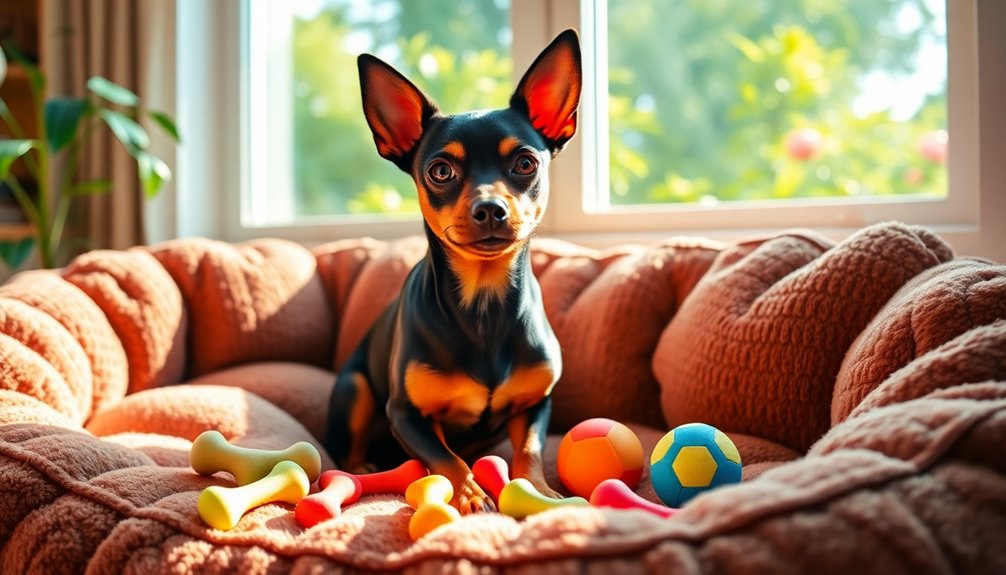
When it comes to your Miniature Pinscher's health and lifespan, you can expect them to live around 12 to 15 years, with some reaching up to 20 in rare cases. However, they do face common health concerns like dental disease and genetic predispositions, such as patellar luxation. Proper care and health maintenance are crucial for longevity and can significantly enhance their overall well-being.
Typical lifespan of the breed
The typical lifespan of a Miniature Pinscher ranges from 12 to 15 years, though some may live up to 16 years or even reach 17 with exceptional care. Several factors influence how long your Miniature Pinscher will be by your side. Genetics plays a significant role, but your care and attention can make a big difference.
Providing a balanced diet tailored to their age, size, and energy level is crucial for their longevity. Regular veterinary visits and preventive health measures are essential to catch any issues early on. Keeping your pup at a healthy weight helps prevent obesity-related problems that can shorten their lifespan. Regular exercise is particularly important in maintaining cardiovascular health, which contributes to a longer life.
Don't forget about exercise! Regular walks and play sessions are necessary for their physical and mental health. A stimulating environment reduces stress and contributes to a longer life.
As your Miniature Pinscher ages, you might notice decreased activity levels, graying fur, or a decline in senses like hearing and vision. Being aware of these signs and maintaining good dental care can help ensure your furry friend enjoys a long, healthy life by your side.
Common health concerns or genetic predispositions
Understanding common health concerns and genetic predispositions in Miniature Pinschers can help you take proactive steps to ensure your furry friend stays healthy.
One of the most prevalent orthopedic issues is patellar luxation, where a dislocated kneecap leads to sudden hind leg lifting or a "bunny hop" gait. Another significant concern is Legg-Calve-Perthes disease, which affects young dogs and can result in painful hip degeneration. Additionally, the high energy levels of Miniature Pinschers mean they require regular exercise to prevent obesity-related health issues.
You should also be aware of intervertebral disc disease (IVDD), often linked to chondrodystrophy, which can cause severe back problems.
Metabolic disorders like mucopolysaccharidosis VI can lead to stunted growth and skeletal issues, while obesity poses risks for joint problems and other health complications. Regular veterinary check-ups are essential for monitoring endocrine issues and identifying potential genetic disorders through testing.
Ocular health is another area of concern; cataracts and other eye conditions can lead to blindness if not addressed promptly.
Additionally, Miniature Pinschers are susceptible to infectious diseases and parasites. Maintaining a proper vaccination schedule and preventive care will help keep your pup healthy and thriving.
Tips for maintaining health and wellness
Maintaining health and wellness in your Miniature Pinscher is crucial for a long and happy life. Start by feeding a balanced, high-quality diet that suits your pup's age, size, and energy level. This helps prevent obesity, which can lead to serious health issues like diabetes and joint problems. Additionally, providing a clean environment with good air quality can contribute to your dog's overall health.
Avoid giving them leftover people food and doggie treats, and closely monitor their food intake.
Daily exercise is essential. Engage in walks, playtime, or agility training to keep them physically fit and mentally stimulated. Tailor these activities to your dog's energy levels and age, ensuring they stay healthy and happy. Miniature Pinschers are known for their energetic and playful demeanor, which makes regular exercise even more important to keep them engaged.
Dental health is another vital aspect. Regularly clean their teeth using dog-specific toothpaste and a soft toothbrush, and incorporate dental chews into their routine. This helps prevent tooth decay and other dental issues.
Lastly, don't overlook veterinary care. Schedule annual check-ups to catch any health issues early, follow a proper vaccination schedule, and implement year-round prevention for ticks, fleas, and heartworms.
Consult your vet for personalized advice on diet, exercise, and weight management to keep your Miniature Pinscher thriving.
Care Requirements

Taking care of your Miniature Pinscher involves a few key elements, including minimal brushing due to their short coat and meeting their exercise needs. It's important to be aware that routine health checks can help identify any potential issues early on. You'll want to ensure they get plenty of daily activity to match their energy levels while keeping an eye on their diet to prevent obesity. Adequate exercise levels are essential to maintain their overall health and prevent behavioral issues.
Let's explore some effective feeding tips and exercise routines to keep your pup healthy and happy.
Minimal Brushing Required
When it comes to caring for a Miniature Pinscher, minimal brushing is required due to their short, smooth coat.
You'll want to brush your pup weekly to remove loose hair and distribute their natural oils, keeping their coat looking its best. A soft bristle brush or a rubber grooming mitt works well for this task. Fortunately, these little dogs shed very little, so you won't have to spend hours grooming.
Bathing every 1-2 months will suffice, or more often if your Mini isn't looking clean. Always use a gentle, dog-approved shampoo to maintain their coat's health and shine. Avoid human shampoo, as it can cause skin irritation and dryness. A quick wipe-down with a damp cloth can help in between baths.
In addition to coat care, don't forget about other grooming needs. Regular nail trimming every 3-4 weeks prevents discomfort, while weekly ear cleaning and bi-weekly teeth brushing keep your Mini healthy. Regular grooming sessions also offer an opportunity to monitor for signs of ticks or fleas, ensuring your Mini stays happy and healthy.
Lastly, check their skin and eyes during grooming sessions for any issues. With these simple maintenance tasks, your Miniature Pinscher will thrive!
Exercise requirements and energy levels
Miniature Pinschers have a lively spirit that demands regular exercise to stay healthy and happy. You'll need to provide at least 30 to 60 minutes of exercise each day, with a focus on energy-burning activities. Daily walks are essential, ideally lasting 20 to 45 minutes at a brisk pace.
Incorporate a variety of activities, like brisk walking once or twice a day, and play sessions in a secure area. Games like fetch and agility courses will keep your Min Pin engaged and entertained. Additionally, these dogs can reach speeds of 45 mph in short bursts, making high-energy activities particularly beneficial.
Don't forget mental stimulation through obedience training and puzzle toys—these are crucial for their intelligence.
Be mindful of weather conditions; Min Pins don't tolerate cold well, so a warm sweater is necessary during winter walks. In hot weather, exercise during cooler times of the day to prevent overheating. An escape-proof yard with a tall fence is a must if you plan to let them play outside.
As your Min Pin ages, adjust their exercise routine, offering shorter, more frequent walks. Consistent exercise helps prevent obesity and keeps their mind active at every life stage, ensuring they remain social, fit, and healthy.
Feeding tips and diet recommendations
Maintaining a balanced diet is vital for keeping your Miniature Pinscher healthy and energetic. Aim for daily caloric intake between 320 to 400 calories.
Focus on high-quality proteins like beef, chicken, turkey, and fish to support muscle mass. Incorporate healthy fats, including Omega-3 and Omega-6 fatty acids, for energy and a shiny coat. A raw food diet can avoid negative effects commonly associated with kibble, such as insulin spikes and inflammation.
When it comes to carbohydrates, opt for complex sources such as sweet potatoes, brown rice, and oats to provide lasting energy. Essential vitamins and minerals, especially vitamins A, D, E, and B-complex, along with calcium and phosphorus, play a crucial role in immune health and bone strength.
Feed your adult Miniature Pinscher two meals a day, offering 1/4 to 3/4 cups of food each time. Puppies need three meals daily until six months, with 1/2 to 1 cup per meal.
Regular feeding times enhance digestive health, while portion control prevents overfeeding. Consider your dog's age and adjust their diet accordingly. Senior dogs often need fewer calories and more fiber.
Always ensure fresh water is available, and tailor the diet to your dog's individual needs, including their activity level and any health conditions.
Training and Socialization

When training your Miniature Pinscher, you'll find their moderately independent nature can make consistency crucial. Gradually introducing your pup to new friends will help ease any leash reactivity or barking issues they might develop. To enhance their learning experience, ensure you maintain consistent training schedules that reinforce positive behaviors effectively.
Moderately Independent Training Style
Training a Miniature Pinscher requires a moderately independent style that balances guidance with freedom. Start early to establish good habits and prevent bad ones. Enroll in puppy training classes to enhance their socialization and learning. Consistency in your approach—schedule and expectations—is crucial.
Keep training sessions short and engaging, ideally lasting 10-15 minutes, 2-3 times a day. Use clear and simple commands to minimize confusion.
Focus on positive reinforcement by rewarding good behavior with treats, praise, or toys. This helps your pup associate desired behavior with positive outcomes. Instead of punishing bad behavior, gently redirect to positive alternatives. As your Miniature Pinscher becomes more proficient, gradually phase out treats.
Socialization is vital to prevent aggression and fearfulness. Expose your dog to various environments, people, and animals from an early age. This ongoing socialization helps develop confidence and appropriate behavior, reducing the risk of excessive barking. Additionally, ensure you provide adequate exercise to support their mental well-being, as regular activity is essential for a well-rounded Miniature Pinscher.
Lastly, practice patience and stay calm during training. Remember, puppies learn at different paces, so set realistic expectations for progress. With a balanced approach, your Miniature Pinscher will thrive in training and social settings.
Gradual Introductions to New Friends
Gradually introducing your Miniature Pinscher to new friends is crucial for their social development. Start by exposing your puppy to controlled environments, like a quiet park during off-hours. This minimizes overwhelm while allowing them to experience various sights, sounds, and smells safely. Always monitor their reactions and adjust the exposure accordingly.
Use positive reinforcement during these interactions. Treats, toys, and praise can transform new experiences into enjoyable ones. Keep sessions short to maintain your puppy's engagement, and avoid any form of punishment, as it can create negative associations. Consistency in your rewards and praise is key. Early exposure to different environments is essential in shaping your puppy's long-term temperament.
Introduce your puppy to a variety of people, including children, seniors, and even those in uniforms. Arrange playdates with other well-behaved, vaccinated dogs, and expose them to different pets if possible. Always supervise these interactions to ensure safety and positivity.
Involve all family members in the socialization process to maintain consistent methods and rules. Keep track of new experiences with a puppy checklist to identify areas needing more focus.
Watch for stress signals like excessive panting or tail-tucking and adjust as needed. Regular vet visits can also help your puppy feel comfortable around strangers.
Leash Reactivity and Barking
Leash reactivity in Miniature Pinschers can be a frustrating challenge, but understanding its causes and managing it effectively can lead to more enjoyable walks. This behavior often stems from insecurities or a feeling of being cornered, along with a lack of socialization. If your pup hasn't had positive experiences with people and other dogs, they might react out of suspicion or protectiveness. Signs include barking, pulling on the leash, and even aggression.
To reduce reactivity, focus on training techniques. Teach your dog a "focus" command to distract them from triggers. Use positive reinforcement with treats and praise, and consider a no-pull harness to discourage pulling. When your dog starts to pull, stop walking until they calm down. Establishing rules and structure is critical for helping your Miniature Pinscher learn and feel more secure.
Socialization is key, especially between 3 to 14 weeks of age. Gradually introduce your pup to new experiences in controlled environments, rewarding calm behavior and avoiding overwhelming situations.
Approach new people and dogs from a distance to prevent reactive outbursts. By managing your dog's energy levels before walks and maintaining consistent training methods, you'll help your Miniature Pinscher feel more secure and less reactive.
Ideal Living Environment
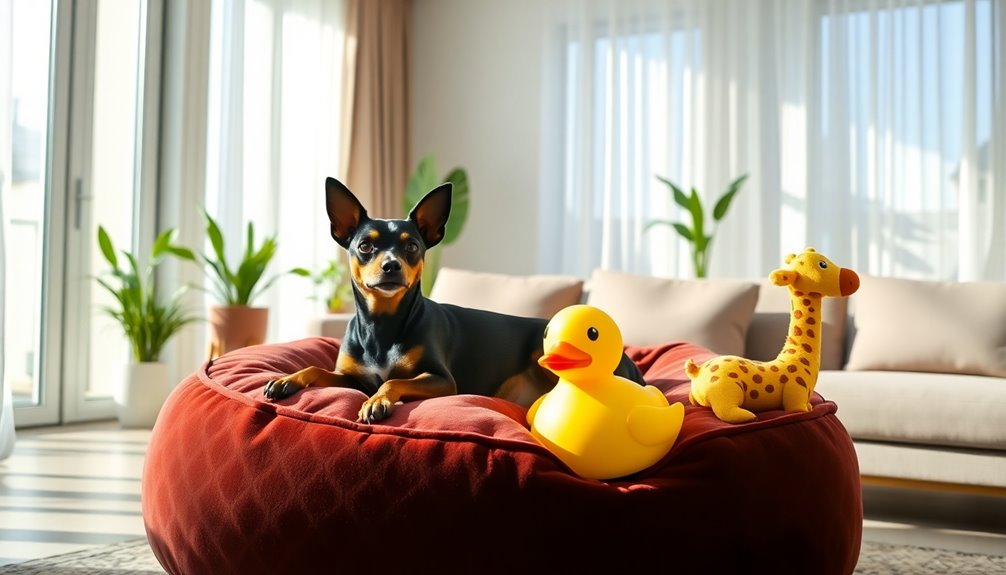
If you live in an urban apartment, a Miniature Pinscher can thrive in your space, thanks to their small size and adaptability. Just remember, they need regular exercise and mental stimulation to stay happy and healthy, especially in a confined environment. Additionally, be mindful of hot weather, as these dogs can struggle in high temperatures, so always ensure they've a cool, safe spot to relax. Prioritizing balanced nutrition is also important for their overall health, so make sure to provide them with a well-rounded diet. Early socialization is crucial for developing good social skills, so it's important to expose them to various people and environments.
Urban Apartment Living
For those living in urban apartments, Miniature Pinschers can be an ideal companion, thanks to their small size and adaptability. These little dogs thrive in smaller spaces, provided you give them adequate mental and physical stimulation. Regular barking can also serve as an alert to perceived threats, making them vigilant companions.
Creating a dedicated area for your Miniature Pinscher, complete with a comfortable bed and engaging toys, is essential for their well-being.
Daily exercise is crucial, so aim for 30 to 60 minutes of activity each day. Regular walks and indoor play sessions help keep them healthy and content. Incorporating training and indoor games can effectively expend their energy, especially when outdoor space is limited.
Remember, failure to meet their exercise needs can lead to destructive behaviors.
Training and socialization are key. Miniature Pinschers are intelligent and can learn quickly with consistent, positive reinforcement. Early socialization and obedience training help them adapt to apartment living and develop good social skills.
Since they can be vocal, managing their barking is important. Teaching commands like 'quiet' can help reduce unnecessary noise, creating a harmonious living environment for you and your Miniature Pinscher.
Hot Weather Tolerance
During the hotter months, keeping your Miniature Pinscher comfortable requires special attention to their needs. This breed doesn't tolerate extreme heat well, so it's crucial to create a suitable living environment for them. Ideally, they thrive in temperate zones where temperatures aren't too high.
Since Miniature Pinschers have a short, thin coat, they lack adequate insulation against heat. This makes them more vulnerable to heat-related health issues, especially when outdoor temperatures soar. You should limit their outdoor time during peak heat hours and ensure they've a cool, shaded area to rest. Proper hydration is essential, so always provide fresh water. To maintain their health, be mindful that their average lifespan is around 12 to 16 years, which underscores the need for careful heat management.
In addition, consider the ventilation in their living space. Make sure it's well-ventilated and cool, as their small size doesn't protect them from heat stress. Regular grooming can help keep their coat clean and assist with cooling.
Lastly, don't forget the importance of regular veterinary check-ups. Monitoring their health can help identify any heat-related issues early on, ensuring your Miniature Pinscher stays happy and healthy even in warmer weather.
Vocal Alertness to Intruders

When it comes to guarding your home, Miniature Pinschers are alert and sensitive to any intruders. Their keen hearing and sharp eyesight make them quick to notice unusual activity, and they won't hesitate to bark to alert you. This vocal alertness is one of the many traits that make them exceptional watchdogs. Their strong territorial instincts further enhance their ability to protect your home from potential threats.
Distinctive High-Stepping Gait
Although the Miniature Pinscher's distinctive high-stepping gait is often admired for its elegance, it also plays a crucial role in the breed's identity and functionality. Derived from the trot of the Hackney horse, this gait showcases a unique high-stepping action.
As you observe, the front legs move straight forward and in front of the body, bending at the wrist during the motion. The rear legs drive smoothly, creating an effortless stride that defines the breed. The overall package of the Miniature Pinscher includes outline, balance, movement which further emphasizes the importance of their gait.
When judging Miniature Pinschers, this gait is a key characteristic to consider. It's essential to balance it with soundness and temperament, avoiding excessive leg lift that could lead to undesirable traits. The movement should be quick and smooth, reflecting the breed's charm and confident nature.
You'll notice this gait in everyday activities, like your dog trotting around the room, showcasing a free and easy style. The moderately angled front and more angulated rear contribute to this distinctive appearance, helping solidify the Miniature Pinscher's reputation as the "King of Toys."
Each step embodies the breed's history, personality, and undeniable charisma.
Featured in 'The Little Rascals
Miniature Pinschers, often spotlighted in popular culture like 'The Little Rascals,' are renowned for their vocal alertness to intruders. These spirited little dogs possess excellent hearing and keen eyesight, making them quick to detect unusual sounds and movements around your home. Their instinctive barking serves as a crucial warning system, alerting you to potential threats.
Despite their small size, Miniature Pinschers excel as watchdogs, and their bold, insistent bark can easily challenge intruders. Their protective instincts make them fiercely loyal companions. They form strong bonds with their families and will go to great lengths to safeguard their territory. In fact, their high energy levels contribute to their vigilance, allowing them to remain alert and active in monitoring their surroundings.
While they're not inherently aggressive, their vigilant nature means they're often wary of strangers, ready to bark and alert you to their presence. However, without proper training, their barking can become excessive, so it's essential to manage this behavior early on.
Early socialization is crucial to ensure they behave appropriately around strangers. With consistent training, you can harness their protective instincts while enjoying a well-mannered companion.
Ultimately, Miniature Pinschers' vocal alertness not only deters intruders but also showcases their commitment to protecting you and your home.
Active Lifestyle Compatibility
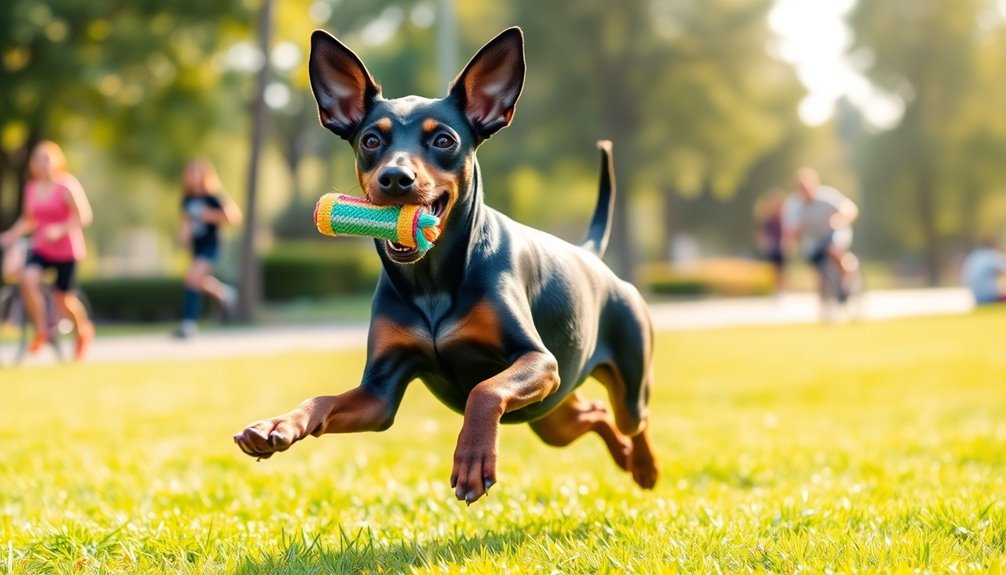
If you lead an active lifestyle, a Miniature Pinscher could be the perfect companion for you.
With their high energy levels and need for daily exercise, they thrive on brisk walks, running, and engaging playtime.
You'll find that their spirited nature keeps you motivated and adds excitement to your routine. Additionally, they are known for their agile and capable abilities, making them excellent partners for various outdoor activities.
Energetic Companion for Active Owners
For those who thrive on an active lifestyle, the Miniature Pinscher makes an ideal companion. This small, agile breed is perfect for apartment living, as it can easily meet its exercise needs in compact spaces. You'll appreciate that Min Pins can enjoy playtime indoors or in small yards, but you must ensure your home is secure to prevent them from escaping.
If you lead an active life, you'll need to engage in regular physical activities with your Miniature Pinscher. Daily walks and play sessions are essential to keep them happy and content. Additionally, their high-energy nature means that you'll need to provide ample stimulation to prevent boredom.
Remember, if you're not up for the challenge, an inactive lifestyle may leave you overwhelmed, as these dogs thrive on energy and excitement. Min Pins form strong bonds with their owners and family members, making them great companions. They do best with older, dog-experienced children and can be a bit independent and stubborn. Early socialization and consistent training are crucial to help them adapt. While they might be aloof with strangers, their loyalty to family is unwavering, making them not just energetic companions, but also loving family members.
High Energy and Exercise Needs
Maintaining a high energy level is essential for your Miniature Pinscher, as they thrive on regular exercise and mental challenges. Aim for at least 30 to 60 minutes of exercise daily, mixing physical activities with mental stimulation.
Daily walks are vital, ideally lasting 20 to 45 minutes at a brisk pace. You can split this into one or two walks depending on your schedule. Additionally, these dogs enjoy a variety of activities that cater to their dynamic nature, making them a joy to have around.
Incorporate brisk walks to release pent-up energy, along with play sessions in a secure area—fetch and frisbee work wonders. Engage your pup with interactive games like agility training and obedience drills. Flirt pole exercises can quickly burn off energy, while puzzle toys keep their minds sharp. Additionally, the Miniature Pinscher's adaptability to apartment living makes it a great choice for active owners in urban settings.
Adjust exercise routines according to your dog's life stage. For puppies, opt for short, frequent play sessions. Senior dogs benefit from shorter, gentler walks and regular mental exercises.
Keep environmental factors in mind; exercise during cooler parts of the day in hot weather and dress your pup in a sweater during cold spells. Regular, consistent exercise is key to keeping your Miniature Pinscher happy and well-behaved.
Frequently Asked Questions
Do Miniature Pinschers Shed a Lot of Fur?
Yes, Miniature Pinschers do shed, but it's not excessive.
You'll find their sleek coat sheds moderately throughout the year, with more noticeable shedding during specific seasons.
Factors like diet and health can influence how much they shed.
Regular grooming, such as weekly brushing, can help manage the loose hair and keep your Min Pin's coat healthy and shiny.
Are Miniature Pinschers Good With Children?
Miniature Pinschers can be good with children, but it really depends on the individual dog's temperament and how well they've been socialized.
Since they're lively and playful, they can make great companions for kids, but supervision during playtime is crucial.
You'll want to teach your children how to interact gently and safely with your Miniature Pinscher.
Early socialization and consistent training will help ensure a positive relationship between your dog and your kids.
What Is the Average Weight of a Miniature Pinscher?
The average weight of a Miniature Pinscher typically ranges from 8 to 10 pounds, with some individuals reaching up to 11 pounds.
You'll find that this weight is consistent across most breed standards, with both males and females falling within the same range.
It's important to remember that factors like genetics, diet, and lifestyle can influence a dog's weight, so keeping an eye on their health is essential for their overall well-being.
How Often Should I Groom My Miniature Pinscher?
You should groom your Miniature Pinscher at least once a week. This routine helps remove loose fur and distribute skin oils, keeping their coat shiny and healthy.
Use a soft bristle brush or grooming mitt for best results. Bathing isn't necessary often—every 1-2 months is sufficient, or when they get especially dirty.
Also, trim their nails every 3-4 weeks to ensure comfort and prevent mobility issues. Regular grooming helps maintain overall health.
Can Miniature Pinschers Be Left Alone for Long Periods?
You shouldn't leave Miniature Pinschers alone for long periods.
While adult dogs can handle a few hours if their needs are met, they're prone to separation anxiety and may become destructive.
It's crucial to gradually acclimate them to being alone.
Provide a comfortable space, interactive toys, and regular exercise to keep them happy.
If you're away often, consider hiring a pet sitter or dog walker to ensure they receive the attention they need.
Conclusion
In conclusion, the Miniature Pinscher truly is the king of toys, bringing energy and joy into your life. With their spirited personality and keen alertness, they make excellent companions for those who appreciate an active lifestyle. By providing the right training and socialization, you'll surely enjoy a harmonious bond with your Min Pin. So, if you're ready for a lively, loving friend, this little dynamo might just be the perfect addition to your home!



